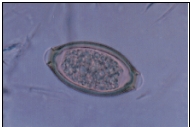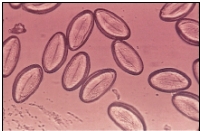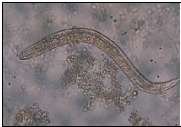A) Ancylostoma duodenale
B) Enterobius vermicularis
C) Strongyloides stercoralis
D) Trichinella spiralis
F) C) and D)
Correct Answer

verified
Correct Answer
verified
Multiple Choice
All of the following have life cycles that require larval lung migrations EXCEPT:
A) Ascaris lumbricoides
B) Necator americanus
C) Strongyloides stercoralis
D) Trichuris trichiura
F) B) and C)
Correct Answer

verified
Correct Answer
verified
Multiple Choice
The nematode parasite that may complete its life cycle without leaving the host is:
A) Ascaris lumbricoides
B) Necator americanus
C) Strongyloides stercoralis
D) Toxocara canis
F) A) and B)
Correct Answer

verified
Correct Answer
verified
Multiple Choice
Which of the following parasitic diseases is a zoonosis?
A) Ascaris lumbricoides
B) Dracunculus medinensis
C) Strongyloides stercoralis
D) Trichinella spiralis
F) A) and C)
Correct Answer

verified
Correct Answer
verified
Multiple Choice
The nematode infection that is acquired by ingesting a Cyclops (water flea) is:
A) Dracunculus medinensis
B) Enterobius vermicularis
C) Necator americanus
D) Trichinella spiralis
F) None of the above
Correct Answer

verified
Correct Answer
verified
Multiple Choice
Name the parasite shown in the following image: 
A) Ascaris lumbricoides egg
B) Enterobius vermicularis egg
C) Hookworm egg
D) Trichuris trichiura egg
F) A) and D)
Correct Answer

verified
Correct Answer
verified
Multiple Choice
Closed fecal sanitation systems had directly led to the reduction of all of the following nematode infections EXCEPT:
A) Ascariasis
B) Hookworm disease
C) Strongyloidiasis
D) Trichinosis
F) None of the above
Correct Answer

verified
Correct Answer
verified
Multiple Choice
Name the parasite shown in the following image: 
A) Ascaris lumbricoides egg
B) Enterobius vermicularis egg
C) Hookworm egg
D) Trichuris trichiura egg
F) A) and C)
Correct Answer

verified
Correct Answer
verified
Multiple Choice
The rhabditiform larva of Strongyloides stercoralis has a:
A) Long buccal cavity
B) Sheath
C) Large genital primordium
D) Notched tail
F) A) and D)
Correct Answer

verified
Correct Answer
verified
Multiple Choice
Cutaneous larvamigrans is caused by:
A) Ascaris lumbricoides
B) Necator americanus
C) Strongyloides stercoralis
D) Toxocara canis
F) B) and D)
Correct Answer

verified
Correct Answer
verified
Multiple Choice
Name the parasite shown in the following image: 
A) Wuchereria bancrofti-microfilaria
B) Filariform larva
C) Pinworm-female
D) Rhabditiform larva
F) C) and D)
Correct Answer

verified
Correct Answer
verified
Multiple Choice
A soldier returning from Iraq noticed a blister above his ankle that subsequently opened while he was swimming in his family pool. On further examination, he noticed a worm in the open blister. The possible parasite in this lesion is:
A) Ancylostoma duodenale
B) Dracunculus medinensis
C) Toxocara canis
D) Visceral larva migrans
F) B) and D)
Correct Answer

verified
Correct Answer
verified
Multiple Choice
A microfilaria recovered in a blood sample from a patient from Vietnam had two nuclei at the tip of the tail. The worm was enclosed in a sheath. This parasite is:
A) Brugia malayi
B) Loa loa
C) Onchocerca volvulus
D) Wuchereria bancrofti
F) None of the above
Correct Answer

verified
A
Correct Answer
verified
Multiple Choice
All of the following infections are diagnosed by finding microfilaria in blood EXCEPT:
A) Wuchereria bancrofti
B) Onchocerca volvulus
C) Loa loa
D) Brugia malayi
F) All of the above
Correct Answer

verified
Correct Answer
verified
Multiple Choice
Which of the following parasitic diseases can cause blindness?
A) Brugia malayi
B) Loa loa
C) Onchocerca volvulus
D) Wuchereria bancrofti
F) C) and D)
Correct Answer

verified
C
Correct Answer
verified
Multiple Choice
A 7-year-old boy's CBC revealed a microcytic anemia with eosinophilia during an office visit for symptoms of diarrhea. The most likely parasite involved in the infection is:
A) Enterobius vermicularis
B) Necator americanus
C) Trichuris trichiura
D) Wuchereria bancrofti
F) A) and B)
Correct Answer

verified
B
Correct Answer
verified
Multiple Choice
Which of the following organisms or infections could be transmitted in the laboratory?
A) Ascaris lumbricoides-Ascariasis
B) Enterobius vermicularis-pinworm infection
C) Strongyloides stercoralis-Strongyloidiasis
D) Trichuris trichiura-whipworm infection
F) None of the above
Correct Answer

verified
Correct Answer
verified
Multiple Choice
In a general nematode parasite's life cycle, the host may ingest a fertile egg. This stage of the life cycle is referred to as the:
A) Definitive host phase
B) Diagnostic stage
C) Infective stage
D) Method of infection
F) A) and C)
Correct Answer

verified
Correct Answer
verified
Multiple Choice
A parasite that lives inside a host is referred to as a(n) :
A) Accidental parasite
B) Ectoparasite
C) Endoparasite
D) Facultative parasite
F) A) and D)
Correct Answer

verified
Correct Answer
verified
Multiple Choice
Patients who have heavy infections with Necator americanus may exhibit all of the following symptoms EXCEPT:
A) Diarrhea
B) Larval dermatitis
C) Macrocytic anemia
D) Microcytic anemia
F) All of the above
Correct Answer

verified
Correct Answer
verified
Showing 1 - 20 of 34
Related Exams